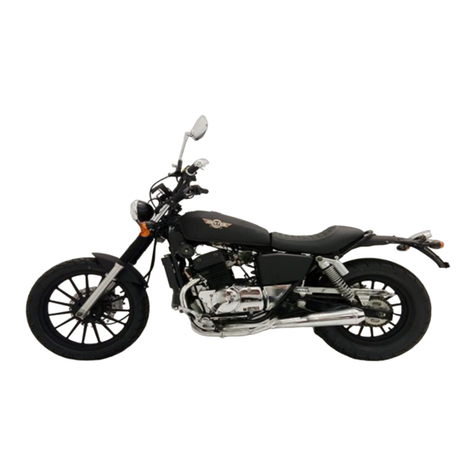10
Note:Introduction of the Speedometer operation
Time adjustment:
At the same time, press and hold the SET+SEL button for 3 seconds (until the time icon on the meter flashes) to enter the
time adjustment mode.Time flashing (unit: hour): Press SET to adjust the time increment.Press and hold SET for 3 seconds
to switch to time flashing (unit: second): adjust by SET increment.After the time is confirmed, press and hold the SET
button for 3 seconds (save/exit) until the time does not flash, and the time adjustment is completed
.
Mileage operation:
Single-point SET button to enter the mileage function mode. Single point SET View switch total mileage/small
mileage.Clear the small mileage: Enter the small mileage interface, press and hold the SET button for 3 seconds (to the
meter icon to display 0km/h), complete the small mileage clear, and record the next new mileage.
ABS mode operation and function switching:
The single-point SEL button enters the ABS mode interface, and the single-point SEL can perform ABS safety mode (SAFE)
and sport mode (SPORT) switching. In safe mode (SAFE): Press and hold the SEL button for 3 seconds to enter the ABS
function area.
The analog icon on the lower right of the meter: the rear wheel flashes, indicating that the rear wheel ABS is off. The
analog icon on the lower right of the meter: the front/rear wheels flash simultaneously, indicating that the front/rear ABS
is off at the same time. The analog icon on the lower right of the meter: the front/rear wheels are simultaneously
displayed (not flashing), indicating that the front/rear ABS is simultaneously turned on.
Similarly, the single-point SEL button enters the sport mode (Sport): press and hold the SEL button for 3 seconds to enter
the ABS function area. The analog icon on the lower right of the meter: the rear wheel flashes, indicating that the rear
wheel ABS is off. The analog icon on the lower right of the meter: the front/rear wheels flash simultaneously, indicating
that the front/rear ABS is off at the same time.The analog icon on the lower right of the meter: the front/rear wheels are
simultaneously displayed (not flashing), indicating that the front/rear ABS is simultaneously turned on.




























